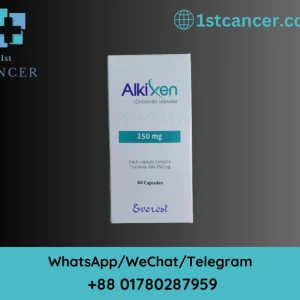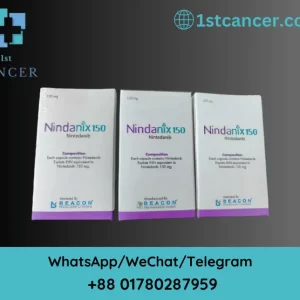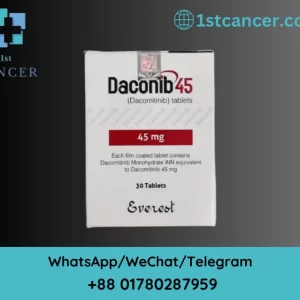In the dynamic landscape of cancer treatment, Capmatinib Tablets emerge as a beacon of hope, a targeted therapy designed to address specific genetic alterations driving the growth of certain cancers. As a potent inhibitor of the MET receptor tyrosine kinase, Capmatinib represents a stride forward in precision medicine, particularly in the realm of non-small cell lung cancer (NSCLC) with MET exon 14 skipping alterations.
Introduction of Capmatinib Tablets (Capmaxen):
In the ever-evolving landscape of cancer treatment, where molecular insights guide therapeutic precision, Capmatinib Tablets stand as a beacon of innovation.

This introduction unveils the narrative surrounding Capmatinib Tablets, a tyrosine kinase inhibitor meticulously designed to address specific genetic alterations driving the growth of certain cancers. From its molecular roots to its clinical applications, Capmatinib embodies the promise of precision medicine in the fight against non-small cell lung cancer (NSCLC) marked by MET exon 14 skipping alterations.
Mechanism of Action: Unlocking Molecular Interventions
Capmatinib’s efficacy resides in its ability to selectively inhibit the MET receptor tyrosine kinase. Within the intricate cellular landscape, MET plays a pivotal role in regulating cell proliferation, survival, and migration. By disrupting aberrant MET signalling, Capmatinib Tablets intervenes in the molecular pathways that propel tumour growth, offering a targeted and precise mechanism of action.
Clinical Indications: Tailoring Treatment to Genetic Profiles
The primary clinical application of Capmatinib Tablets unfolds in the context of non-small cell lung cancer with MET exon 14 skipping alterations. This specific genetic mutation leads to dysregulated MET activation, fueling tumour progression. Capmatinib, with its targeted inhibition, represents a tailored therapeutic approach designed to address the unique genetic landscape of individuals with MET-altered NSCLC.
Administration and Dosage: A Personalized Approach
Capmatinib Tablets takes form in oral tablets, offering a convenient and patient-friendly mode of administration. The dosage and treatment schedule are meticulously determined by healthcare providers, reflecting a personalized approach that optimizes efficacy while managing potential side effects. This individualized dosing strategy aligns with the principles of precision medicine.
Clinical Efficacy: Insights from Rigorous Evaluation
The journey of Capmatinib Tablets from laboratory discovery to clinical practice is marked by rigorous evaluation through clinical trials. Positive outcomes from these trials underscore the drug’s efficacy and safety profile, solidifying its role as a viable treatment option for individuals with MET-altered NSCLC. Insights gained from these trials contribute to the evolving understanding of Capmatinib’s place in the therapeutic landscape.
Potential Side Effects: Navigating Treatment Nuances
While offering targeted therapy, Capmatinib Tablets, like any medication, may be associated with potential side effects. Understanding and managing these nuances are essential for healthcare providers. Gastrointestinal disturbances, fatigue, and changes in liver function are among the considerations in the delicate balance between therapeutic benefits and patient well-being.
Future Directions: Pioneering Precision Oncology
As research continues to unfold, Capmatinib Tablets stands at the forefront of precision oncology. Ongoing investigations explore its efficacy in different contexts, potential combination therapies, and adaptive strategies to overcome resistance. Capmatinib’s role in the dynamic landscape of cancer treatment symbolizes not just a drug but a pivotal player in the transformative era of precision medicine.
In conclusion, Capmatinib’s introduction to the world of cancer therapeutics signifies a shift towards targeted precision, where the intricacies of genetic alterations are harnessed to redefine treatment paradigms. This journey from bench to bedside encapsulates the promise of Capmatinib Tablets in the ongoing narrative of precision oncology.
Background of Capmatinib Tablets (Capmaxen):
To appreciate the significance of Capmatinib Tablets in the landscape of cancer therapeutics, it is essential to delve into the background of this tyrosine kinase inhibitor, tracing its origins, molecular foundations, and the clinical context that propelled it into the forefront of precision oncology.
The Genesis of Targeted Therapies:
Capmatinib Tablets emerges within the context of a paradigm shift in cancer treatment – the era of targeted therapies. Traditionally, chemotherapy acted as a blunt force, affecting rapidly dividing cells, both cancerous and healthy. However, the dawn of targeted therapies marked a departure from this approach, aiming to pinpoint specific molecular abnormalities within cancer cells.
Molecular Insights into MET Alterations:
At the heart of Capmatinib’s development lies the recognition of aberrations within the MET pathway. The MET receptor, a tyrosine kinase, plays a crucial role in regulating cellular processes. In certain cancers, particularly non-small cell lung cancer (NSCLC), mutations or alterations in the MET gene, such as exon 14 skipping, lead to uncontrolled MET activation, contributing to tumor growth and progression.
MET-Driven NSCLC: A Clinical Imperative:
Non-small cell lung cancer with MET exon 14 skipping alterations represents a distinct clinical entity. Patients with this specific genomic profile often face challenges posed by aggressive disease progression and limited treatment options. Recognizing the clinical imperative to address MET-driven NSCLC, Capmatinib Tablets was developed as a targeted intervention aimed at disrupting the oncogenic signaling cascades fueled by dysregulated MET.
Preclinical Promise: From Bench to Bedside:
Capmatinib’s journey from preclinical studies to clinical application is marked by promising results in early laboratory investigations. Preclinical models demonstrated the inhibitor’s ability to selectively target MET-altered cancer cells while sparing normal cells. This laid the foundation for translating molecular insights into tangible therapeutic advancements.
Clinical Trials: Rigorous Evaluation and Validation:
The background of Capmatinib Tablets extends into a comprehensive phase of clinical trials, where its safety and efficacy were rigorously evaluated in human subjects. Positive outcomes from these trials, including the GEOMETRY mono-1 trial focusing on MET-altered NSCLC, propelled Capmatinib towards regulatory approval, validating its clinical utility in a real-world context.
Regulatory Milestones and Approval:
Building on the scientific foundation and positive clinical data, Capmatinib achieved regulatory milestones. In 2020, it received approval from regulatory agencies, including the United States Food and Drug Administration (FDA) and the European Medicines Agency (EMA), for the treatment of metastatic NSCLC with MET exon 14 skipping alterations, marking a pivotal moment in the paradigm of precision medicine.
The Ongoing Evolution: Future Avenues and Developments:
As Capmatinib Tablets takes its place in the armamentarium against MET-altered NSCLC, the background narrative extends into the future. Ongoing research explores its efficacy in diverse contexts, potential combination therapies, and adaptive strategies to address resistance mechanisms. Capmatinib’s background sets the stage for its continued evolution as a key player in the dynamic landscape of precision oncology.
In conclusion, the background of Capmatinib Tablets intertwines scientific discovery, clinical imperative, and regulatory validation. From its molecular genesis to regulatory milestones, Capmatinib’s journey underscores the transformative potential of targeted therapies, offering new hope to individuals facing the complexities of MET-altered non-small cell lung cancer.
Mechanism of Action of Capmatinib Tablets (Capmaxen):
At the core of Capmatinib’s therapeutic prowess lies a sophisticated mechanism of action, finely tuned to disrupt the intricate signalling pathways orchestrated by the MET receptor tyrosine kinase. The precision with which Capmatinib intervenes in these molecular cascades marks its role as a targeted therapy, specifically designed to address cancers characterized by dysregulated MET activity, such as non-small cell lung cancer (NSCLC) with MET exon 14 skipping alterations.
1. Targeting the MET Receptor:
- Recognition of MET Alterations: Capmatinib’s journey begins with the recognition of MET alterations, particularly exon 14 skipping mutations, prevalent in certain cancers. These alterations lead to abnormal MET activation, contributing to uncontrolled cell growth and survival.
- Selective Binding to MET: Capmatinib Tablets exhibits selectivity in its binding affinity, specifically targeting the MET receptor. By doing so, it interferes with the binding of natural ligands to MET, disrupting the activation of downstream signaling pathways.
2. Inhibition of Tyrosine Kinase Activity:
- Tyrosine Kinase Inhibition: The MET receptor is a tyrosine kinase, playing a pivotal role in intracellular signaling. Capmatinib Tablets acts as a tyrosine kinase inhibitor, blocking the enzymatic activity of MET. This inhibition is crucial, as it prevents the phosphorylation of tyrosine residues, a key step in the activation of signaling cascades.
3. Disruption of Downstream Signaling:
- Mitigation of Oncogenic Signaling: MET activation triggers a series of downstream signalling pathways, including the RAS-RAF-MEK-ERK and PI3K-AKT-mTOR pathways. Capmatinib’s intervention disrupts these cascades, mitigating oncogenic signalling that fuels cell proliferation, survival, and migration.
- Induction of Apoptosis: By impeding prosurvival signals and inducing proapoptotic signals, Capmatinib Tablets contributes to the promotion of programmed cell death (apoptosis), a crucial mechanism for limiting the growth of cancer cells.
4. Tumor Microenvironment Modulation:
- Impact on Angiogenesis: MET activation within the tumor microenvironment also influences angiogenesis, the formation of new blood vessels to support tumor growth. Capmatinib’s interference with MET signaling extends to the modulation of angiogenesis, restricting the tumor’s ability to establish a nutrient supply through blood vessel formation.
5. Clinical Implications:
- Therapeutic Targeting of MET-Altered Cancers: The precision of Capmatinib’s mechanism of action aligns with its clinical applications, specifically in the treatment of MET-altered cancers. In the context of MET exon 14 skipping alterations in NSCLC, Capmatinib Tablets offers a targeted approach tailored to the unique molecular profile of these tumors.
- Improved Patient Outcomes: By specifically addressing the aberrant MET signaling implicated in cancer progression, Capmatinib holds the potential to improve patient outcomes, offering a therapeutic avenue for those facing limited treatment options associated with MET-altered malignancies.
In conclusion, Capmatinib’s mechanism of action is a testament to the evolution of targeted therapies in precision oncology. By selectively disrupting MET signaling pathways, it exemplifies the potential of tailored interventions in the quest to mitigate the impact of specific genetic alterations driving cancer progression, particularly in the context of MET exon 14 skipping alterations in NSCLC.
Clinical Uses of Capmatinib Tablets (Capmaxen):
Capmatinib, a potent tyrosine kinase inhibitor, finds its clinical niche in the targeted treatment of cancers characterized by dysregulated MET activity. The distinct clinical uses of Capmatinib Tablets are rooted in its precision, specifically addressing non-small cell lung cancer (NSCLC) with MET exon 14 skipping alterations. This section explores the clinical applications of Capmatinib, shedding light on its role in reshaping the therapeutic landscape for individuals facing these unique genetic profiles.
**1. Treatment of MET-Altered NSCLC: A Tailored Approach:
- Genomic Profiling: Capmatinib’s primary clinical use lies in the treatment of NSCLC harboring MET exon 14 skipping alterations. This specific genetic mutation leads to abnormal MET activation, contributing to uncontrolled tumor growth. Genomic profiling of NSCLC patients identifies those with MET alterations, guiding the selection of Capmatinib Tablets as a tailored therapeutic approach.
- Improved Outcomes: The utilization of Capmatinib in MET-altered NSCLC has demonstrated promising results in clinical trials. Improved progression-free survival and overall response rates have been observed, emphasizing its efficacy in addressing the underlying molecular drivers of these specific cancers.
**2. First-Line and Subsequent Therapies:
- First-Line Treatment: Capmatinib Tablets has been explored as a first-line treatment option for MET-altered NSCLC, showcasing its potential as an initial therapeutic choice. This positions Capmatinib as a pivotal player in the evolving landscape of first-line therapies for individuals with MET exon 14 skipping alterations.
- Subsequent Lines of Therapy: In cases where patients have already undergone other lines of treatment, including chemotherapy or immunotherapy, Capmatinib Tablets remains a valuable option. Its role extends beyond the first-line setting, offering a targeted alternative for those who may have exhausted conventional treatment modalities.
**3. Combination Therapies and Ongoing Research:
- Exploration of Combinatorial Approaches: Ongoing research delves into the potential synergies of Capmatinib Tablets with other therapeutic modalities. Combination therapies, such as pairing Capmatinib with immunotherapies or other targeted agents, are under investigation. This exploration aims to optimize treatment responses and overcome potential resistance mechanisms.
- Adaptive Strategies: As the clinical landscape evolves, adaptive strategies involving Capmatinib Tablets continue to be refined. These strategies may include dose adjustments, treatment interruptions, or the exploration of alternative dosing schedules to enhance the durability of response and manage potential side effects.
**4. Clinical Trials in Diverse Settings:
- Expansion of Clinical Investigations: Beyond its established uses, Capmatinib Tablets is the subject of ongoing clinical trials in diverse settings. These trials explore its efficacy in different cancer types and as a part of novel therapeutic combinations. The expansion of clinical investigations highlights the dynamic nature of Capmatinib’s clinical utility and its potential applications beyond the current scope.
**5. Potential for Earlier Detection and Intervention:
- Molecular Profiling for Early Identification: Capmatinib’s clinical uses extend beyond treatment; it holds promise in the realm of early detection and intervention. Molecular profiling of tumors enables the identification of MET alterations at earlier stages, potentially allowing for more targeted therapeutic interventions and improved outcomes.
In conclusion, the clinical uses of Capmatinib Tablets reflect a paradigm shift in the treatment of MET-altered cancers, particularly in NSCLC with exon 14 skipping alterations. Its role as targeted therapy, both in first-line and subsequent settings, positions Capmatinib as a cornerstone in precision oncology, offering renewed hope for individuals with limited therapeutic options associated with MET dysregulation. Ongoing research and exploration of combination therapies underscore its dynamic role in shaping the future of cancer treatment.





